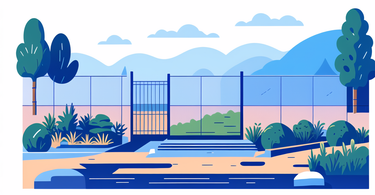The Rise of Sustainable Garden Fencing in the US Market
Understanding the Demand for Eco-Friendly Solutions
Eco-friendly garden fences are gaining popularity in the US. Homeowners want to reduce their carbon footprint. They seek options that are kind to nature and look good. This trend reflects a growing awareness of environmental issues.

Many people now prefer sustainable materials for their outdoor spaces. They want fences that blend with nature and last long. Eco-friendly fences often use recycled or renewable materials. These choices help conserve resources and reduce waste.
Consumers are willing to pay more for sustainable options. They see it as an investment in the planet's future. This shift in mindset is driving innovation in fence design and materials.
The Environmental Impact of Traditional Fencing Materials
Traditional fencing materials can harm the environment. Wood fences often use timber from unsustainable sources. This contributes to deforestation and habitat loss. Treated wood contains chemicals that can leach into the soil.
Metal fences require mining and processing of raw materials. This process uses a lot of energy and creates pollution. Vinyl fences are made from plastic, which is not biodegradable. They can release harmful chemicals over time.
These materials also have a high carbon footprint due to production and transport. When they wear out, they often end up in landfills. This adds to the growing problem of waste management.
Key Trends Shaping the Future of Garden Fencing
Several trends are changing the garden fencing industry. One is the use of composite materials. These blend recycled wood and plastic for a durable, eco-friendly option. Another trend is the rise of living fences made from plants and shrubs.
Modular fence designs are gaining popularity. They allow for easy replacement of damaged sections. This reduces waste and extends the fence's lifespan. Solar-powered fences are another innovation. They provide lighting and security without extra energy costs.
Customization is also a growing trend. People want fences that reflect their personal style. Manufacturers are responding with more color and texture options in sustainable materials.
Innovative Garden Fence Ideas That Honor the Environment
Exploring Biodegradable and Recycled Materials
Biodegradable fences are made from natural materials that break down over time. Bamboo is a popular choice. It grows quickly and doesn't need pesticides. Willow and hazel are other options. They can be woven into beautiful, rustic fences.

Recycled plastic fences give new life to waste materials. They're durable and don't need painting. Some companies use ocean plastic to make fences. This helps clean up our seas while creating useful products.
Reclaimed wood fences use timber from old buildings or fallen trees. They have character and history. Each piece is unique, adding charm to your garden. These fences reduce demand for new lumber.
Integrating Nature into Your Garden Fence Design
Living fences are a natural way to define your space. They can be made from hedges, vines, or trees. These fences provide habitat for wildlife and improve air quality. They also change with the seasons, adding dynamic beauty to your yard.
Vertical gardens can be incorporated into fence designs. They use the fence as a support for growing plants. This maximizes space in small gardens. It also helps cool the area and absorb rainwater.
Some fences include built-in planters or bird houses. These features make the fence part of the garden ecosystem. They create a seamless blend between the boundary and the natural world.
Smart Fences: The Intersection of Technology and Sustainability
Smart fences combine eco-friendly materials with modern tech. Solar-powered sensors can detect intruders or monitor garden conditions. LED lights can be integrated for nighttime safety and ambiance. These features use renewable energy.
Some smart fences have built-in irrigation systems. They water nearby plants efficiently. Others can change color or transparency. This allows for privacy when needed and views when desired.
There are even fences that generate their own power. They use wind or kinetic energy from movement. This energy can power garden tools or charge devices. It's a step towards self-sustaining outdoor spaces.
Implementing and Maintaining a Sustainable Garden Fence
Best Practices for Installation
Installing a sustainable fence starts with proper planning. Consider the local climate and soil type. Choose materials that will last in your environment. This reduces the need for replacements and repairs.

Use eco-friendly concrete alternatives for posts. Some options include recycled plastic post mixes. Others use natural materials like crushed stone. These choices reduce the carbon footprint of your fence.
Work with the natural contours of your land. This minimizes soil disturbance. It also creates a more organic look. Use hand tools where possible to reduce energy use during installation.
Long-Term Care for Your Garden Fence
Sustainable fences need regular care to last. Clean them gently with natural cleaners. Avoid harsh chemicals that can harm plants and soil. Inspect your fence regularly for signs of wear or damage.
Apply natural oils or stains to wooden fences. This protects them without using toxic products. For metal parts, use rust-resistant paints that are low in VOCs. These steps extend your fence's life and maintain its eco-friendly status.
Prune living fences carefully to encourage healthy growth. Compost any trimmings to return nutrients to the soil. Replace damaged sections promptly to prevent further issues.
Measuring the Environmental Benefits of Your Choice
Track the impact of your sustainable fence. Calculate the carbon emissions saved compared to traditional options. Monitor how it affects local wildlife and plant life. This data can inspire others to make eco-friendly choices.
Consider the fence's full lifecycle. How long will it last? Can it be recycled or composted at the end of its life? A truly sustainable fence should have minimal impact from creation to disposal.
Share your experience with neighbors and online communities. Your success can encourage others to adopt sustainable practices. This creates a ripple effect of positive environmental change.
